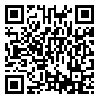Volume 17, Issue 40 (9-2021)
goljaam 2021, 17(40): 216-197 |
Back to browse issues page
Download citation:
BibTeX | RIS | EndNote | Medlars | ProCite | Reference Manager | RefWorks
Send citation to:



BibTeX | RIS | EndNote | Medlars | ProCite | Reference Manager | RefWorks
Send citation to:
vahdanifar O, Daneshvari L. Symbology of the table cloth of Kormanj nomads of North Khorasan. goljaam 2021; 17 (40) : 9
URL: http://goljaam.icsa.ir/article-1-876-en.html
URL: http://goljaam.icsa.ir/article-1-876-en.html
1- Associate Professor, Department of Persian Language and Literature, Faculty of Human Sciences, University of Bojnord, Bojnord, Iran
2- student of Persian language and literature, Faculty of Humanities, University of Bojnord, Bojnord, Iran
2- student of Persian language and literature, Faculty of Humanities, University of Bojnord, Bojnord, Iran
Abstract: (3153 Views)
The most common art of the Kormanj nomads is the weaving of a type of carpet called "Kormanj table" which tells the story of the life or beliefs of that people. This art is specific to the Kermanj-speaking people of North Khorasan and is popular in the cities of Bojnord, Farouj, Mane and Samalghan, Shirvan and Esfrain. Although the Kurdish table has lost its main use today and is used as a floor covering or has a decorative aspect, its primary use in the past was to place bread. The present study was written in a library method with the aim of examining the symbols in the table cloth motifs of the Kormanj tribe of North Khorasan in order to keep alive the old motifs and symbols that are subject to being forgotten and obsolete. The findings of this research indicate that the motifs used in the Kurdish table of the mentioned people have a high semantic diversity and importance and include four geometric, plant, human and animal groups, of which animal motifs are the most used; Because it is influenced by the nomadic life of the Kormanj people. Among the human motifs, the figure of a girl is seen more often; Because the main weavers of the Kurdish table are women and girls. The tree motif is the most frequent plant motif due to its sanctity and being a sign of life and blessing. Abstract and geometric patterns also have a symbolic and decorative aspect.
Article number: 9
Type of Study: Research |
Received: 2023/04/9 | Accepted: 2023/08/13 | Published: 2023/10/27
Received: 2023/04/9 | Accepted: 2023/08/13 | Published: 2023/10/27
Send email to the article author
| Rights and permissions | |
 |
This work is licensed under a Creative Commons Attribution-NonCommercial 4.0 International License. |






